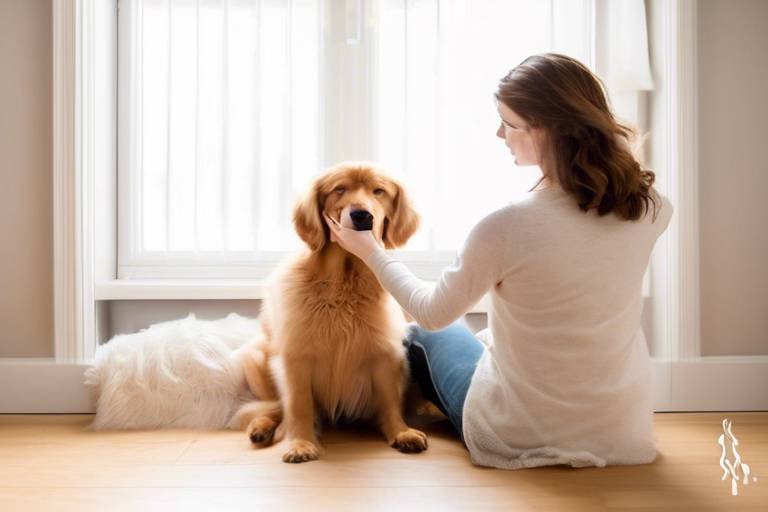How to Help Pets with Allergies Live Comfortably
As pet owners, we all want our furry friends to live their best lives, free from discomfort and pain. Unfortunately, allergies can be a significant hurdle in achieving that goal. Just like humans, pets can suffer from various allergies that can affect their quality of life. These allergies can stem from environmental factors, food, or even seasonal changes, leading to symptoms that can range from mild to severe. But don't worry! There are effective strategies to help alleviate your pet's suffering and ensure they lead happier, healthier lives. In this article, we’ll explore how to identify allergies, manage symptoms, and create a comfortable living environment for your beloved pets.
Allergies in pets can be a complex issue, but understanding the common types of allergies is the first step toward helping your pet. Environmental allergies often arise from pollen, dust mites, or mold, while food allergies can be triggered by specific ingredients in their diet. Seasonal allergies can also play a role, especially during spring and fall when allergens are more abundant. The impact of these allergies on your pet's overall health can be profound, leading to discomfort, behavioral changes, and even chronic health issues. By recognizing the types of allergies your pet may have, you can take proactive steps to mitigate their effects.
Recognizing the signs of allergies in pets is crucial for effective management. Symptoms can vary widely, but some of the most common indicators include:
- Itching and Scratching: If your pet is constantly scratching or biting at their skin, it could signal an allergic reaction.
- Sneezing and Coughing: Just like us, pets can exhibit respiratory symptoms when exposed to allergens.
- Gastrointestinal Issues: Allergies can also manifest as vomiting or diarrhea, particularly with food allergies.
Being vigilant about these symptoms can help you identify whether your pet is suffering from allergies and prompt you to seek appropriate treatment.
Skin allergies are particularly common and can manifest in various ways. You might notice redness, rashes, or excessive scratching on your pet's skin. These reactions can be distressing for both you and your furry friend. Understanding these symptoms is vital in taking the right steps to relieve their discomfort. For instance, a simple change in their grooming routine or the introduction of hypoallergenic products can make a significant difference.
Hot spots are localized areas of inflamed skin that often develop due to scratching or licking. These can be incredibly painful for pets and may require immediate attention. If you notice your pet has a hot spot, it’s essential to keep the area clean and dry. Applying a soothing ointment or visiting your veterinarian can help in treating these irritations effectively.
Flea allergies are another common issue that can cause significant discomfort for pets. Even a single flea bite can trigger an allergic reaction in sensitive animals. Prevention is key here; regular flea treatments and maintaining a clean environment can help keep these pesky parasites at bay. If your pet does develop a flea allergy, various treatment options are available, including topical treatments and oral medications.
Allergies can also lead to respiratory symptoms in pets, such as coughing and sneezing. These symptoms can be alarming, but understanding how to manage them is crucial. Keeping your home free from dust and allergens, using air purifiers, and ensuring proper ventilation can significantly improve your pet's breathing. If symptoms persist, consulting a veterinarian is advisable to explore further treatment options.
Did you know that changing your pet's diet can have a profound impact on managing allergies? Many pets suffer from food allergies that can lead to uncomfortable symptoms. Transitioning to a hypoallergenic diet can help reduce allergic reactions significantly. It's essential to identify potential food allergens, which might require some trial and error. Consulting with a veterinarian can provide invaluable insights into the best dietary choices for your pet.
When selecting hypoallergenic food for your pet, look for products that contain limited ingredients and are free from common allergens like wheat, soy, and dairy. Reading labels carefully can help you make informed choices. Remember, the right nutrition can be a game-changer in managing your pet's allergies!
Regular consultations with a veterinarian can provide tailored advice for managing your pet's allergies. Your vet can help you identify specific allergens and recommend appropriate treatments. They can also guide you on dietary adjustments and any necessary medications to keep your pet comfortable. Professional guidance is essential in navigating the complexities of pet allergies.
Creating a comfortable living space for your pet is vital in managing their allergies. Reducing allergens in your home can significantly improve your pet's quality of life. Simple changes like frequent cleaning, using hypoallergenic bedding, and maintaining good air quality can make a world of difference.
Implementing consistent cleaning routines can help minimize allergens in your home. Regularly vacuuming carpets, washing pet bedding, and dusting surfaces can reduce the accumulation of allergens. Consider using an air purifier to help filter out airborne particles that could trigger your pet's allergies.
Improving indoor air quality can benefit pets with allergies immensely. Investing in a good air purifier can help remove allergens from the air, creating a healthier environment for your furry friend. Additionally, ensuring proper ventilation in your home can help reduce humidity levels, making it less hospitable for mold and dust mites.
Various medications and treatments are available to help manage pet allergies. Options like antihistamines, steroids, and alternative therapies can provide relief. However, it’s crucial to consult with your vet before starting any medication to ensure it’s safe and effective for your pet’s specific needs.
Some over-the-counter medications can help alleviate allergy symptoms in pets. Options like antihistamines can be effective, but it's essential to choose products specifically formulated for pets. Always consult your veterinarian before administering any medication to ensure it's safe for your furry friend.
For pets with severe allergies, allergen immunotherapy may be a viable long-term treatment option. This method involves gradually exposing your pet to small amounts of the allergens that trigger their reactions, helping to desensitize them over time. While it requires commitment, many pet owners find it to be a worthwhile investment in their pet's health.
1. How can I tell if my pet has allergies?
Look for symptoms like itching, sneezing, or gastrointestinal issues. If you're unsure, consult your veterinarian for an accurate diagnosis.
2. Can allergies be cured?
While allergies cannot be completely cured, they can be managed effectively through dietary changes, medications, and environmental controls.
3. Are there specific foods I should avoid for my pet?
Common allergens include wheat, soy, dairy, and certain proteins. A hypoallergenic diet can help identify and eliminate these triggers.
4. How often should I clean my home to help my pet?
Regular cleaning is key! Aim for weekly vacuuming and washing of pet bedding to minimize allergens.
5. When should I consult a veterinarian about my pet's allergies?
If you notice persistent symptoms or if your pet's condition worsens, it's essential to consult a veterinarian for tailored advice and treatment options.

Understanding Pet Allergies
When it comes to our furry friends, allergies can be a real pain in the tail! Just like humans, pets can suffer from various allergies that can significantly affect their quality of life. Understanding what triggers these allergies is the first step in helping them feel better. There are three main types of allergies that can impact pets: environmental allergies, food allergies, and seasonal allergies. Each type has its own set of symptoms and causes, and recognizing them can help you take the right action to ensure your pet remains comfortable and healthy.
Environmental allergies, often caused by pollen, dust mites, mold, and even certain chemicals, can lead to discomfort for your pet. For example, if your dog is sneezing and scratching more than usual, it might be reacting to something in its environment. On the other hand, food allergies can arise when your pet's immune system reacts negatively to certain ingredients in their diet, such as beef, chicken, or grains. This can lead to gastrointestinal issues, skin irritations, and even behavioral changes. Lastly, seasonal allergies often occur during specific times of the year, similar to hay fever in humans, where pets may react to pollen or other seasonal triggers.
Understanding these allergies is crucial for pet owners. It’s not just about recognizing the symptoms; it’s about knowing how to manage them effectively. Here’s a quick overview of the common types of pet allergies:
- Environmental Allergies: Triggered by pollen, dust mites, mold, and chemicals.
- Food Allergies: Caused by certain ingredients in pet food.
- Seasonal Allergies: Occur at specific times of the year due to pollen and other allergens.
By being aware of these allergies, you can take proactive steps to help your pet. This might involve changing their environment, adjusting their diet, or even consulting with a veterinarian for tailored advice. Remember, a happy pet is a healthy pet, and understanding their allergies is the key to unlocking a more comfortable life for them!
Q: What are the signs that my pet has allergies?
A: Common signs include excessive scratching, sneezing, coughing, and gastrointestinal issues. If you notice any of these symptoms, it’s best to consult your veterinarian.
Q: Can I treat my pet's allergies at home?
A: While some home remedies can help, it’s essential to consult your veterinarian for the best treatment options tailored to your pet's specific needs.
Q: Are certain breeds more prone to allergies?
A: Yes, some breeds are more susceptible to allergies than others. For instance, Bulldogs and Retrievers often experience allergies more frequently.
Q: How can I prevent allergies in my pet?
A: Regular cleaning, maintaining a healthy diet, and routine vet check-ups can help prevent allergies from becoming a significant issue.

Identifying Allergy Symptoms
Recognizing the signs of allergies in pets is crucial for their well-being. Just like humans, our furry friends can suffer from various allergies that can make them uncomfortable and irritable. The first step in helping your pet is to be vigilant and observant. Common symptoms can manifest in different ways, and understanding these signs can be the key to ensuring your pet leads a happier life. So, what should you be looking out for?
One of the most noticeable signs is itching. If you see your pet scratching excessively, it could indicate an allergic reaction. This can lead to skin irritations and infections if not addressed promptly. Additionally, you might observe sneezing or coughing, which can suggest respiratory allergies. These symptoms can be quite distressing for your pet, and it’s essential to take them seriously.
Skin allergies can be particularly troublesome. They often manifest as redness, rashes, or even hot spots, which are localized areas of inflamed skin. These hot spots can be incredibly uncomfortable for your pet, leading to more scratching and licking, creating a vicious cycle. If you notice your pet constantly nibbling at a specific area, it’s time to investigate further.
Hot spots are often a result of your pet’s attempt to relieve irritation. They can appear suddenly and can be quite painful. Keeping an eye on your pet’s grooming habits can help you catch these issues early. If you spot a hot spot, it’s important to clean the area and consult your veterinarian for appropriate treatment options.
Flea allergies are another common issue among pets. Even a single flea bite can trigger a severe allergic reaction in some animals. Signs of flea allergies include intense itching, hair loss, and skin infections. To keep your pet flea-free, regular grooming and preventive treatments are essential. If you suspect your pet has a flea allergy, consult your vet for effective management strategies.
Allergies can also lead to respiratory problems in pets. If you notice your pet coughing, sneezing, or experiencing nasal discharge, these could be signs of an allergic reaction. Just like in humans, these symptoms can indicate that your pet is struggling to cope with allergens in their environment. Improving air quality and reducing exposure to known allergens can help alleviate these symptoms.
In summary, being proactive about recognizing allergy symptoms in your pet can significantly improve their quality of life. If you notice any of these signs, don’t hesitate to reach out to your veterinarian for guidance. After all, our pets rely on us to keep them comfortable and healthy!
Q: What are the most common allergies in pets?
A: The most common allergies in pets include environmental allergies (like pollen and dust mites), food allergies, and flea allergies.
Q: How can I tell if my pet has a food allergy?
A: Symptoms of food allergies can include gastrointestinal issues, such as vomiting or diarrhea, as well as skin irritations and itching.
Q: What should I do if I suspect my pet has allergies?
A: If you suspect your pet has allergies, it’s best to consult with your veterinarian. They can provide a proper diagnosis and recommend treatment options.
Skin Reactions
When it comes to our furry friends, skin reactions can be one of the most distressing signs of allergies. Just like humans, pets can suffer from various skin issues that arise due to allergens in their environment or diet. These reactions can manifest in several ways, including redness, rashes, and excessive scratching. Imagine how uncomfortable it must feel for your pet to deal with constant itching or burning sensations! It's crucial for pet owners to recognize these symptoms early on to provide relief and prevent further complications.
One common skin reaction is known as atopic dermatitis, which is often triggered by environmental allergens such as pollen, dust mites, or mold. Pets with this condition may develop inflamed skin, leading to excessive licking or biting in an attempt to soothe their discomfort. If you notice your pet frequently scratching or chewing at certain areas, it's time to investigate further.
Another alarming skin issue is the formation of hot spots. These are localized areas of inflamed skin that can appear suddenly and become quite severe if left untreated. Hot spots often arise from a combination of factors, including allergies, insect bites, or even stress. You might notice your pet obsessively licking a particular spot, which can quickly escalate into a painful, infected area. Early intervention is key to managing hot spots effectively.
To help you better understand the different types of skin reactions that pets may experience, here's a quick overview:
| Type of Skin Reaction | Common Symptoms | Potential Triggers |
|---|---|---|
| Atopic Dermatitis | Redness, itching, hair loss | Pollen, dust mites, mold |
| Hot Spots | Localized redness, oozing, foul odor | Allergies, insect bites, stress |
| Flea Allergy Dermatitis | Itching, hair loss, skin infections | Flea bites |
Recognizing these symptoms early on can make a world of difference in your pet's comfort and overall health. If you observe any signs of skin reactions, it’s essential to consult with a veterinarian. They can provide a proper diagnosis and recommend appropriate treatments, which may include topical medications, antihistamines, or even dietary changes. Remember, your pet relies on you to keep them comfortable and happy, so staying vigilant about their skin health is crucial!
- What are the most common causes of skin allergies in pets?
Skin allergies in pets can be caused by environmental factors like pollen or dust mites, food sensitivities, or flea bites. Identifying the trigger is vital for effective treatment. - How can I soothe my pet's itchy skin?
Consulting a veterinarian is the best course of action. They may recommend medicated shampoos, topical treatments, or dietary adjustments to help alleviate itching. - Are there any home remedies for pet allergies?
While some home remedies can provide temporary relief, it's essential to consult a veterinarian before trying them. They can suggest safe and effective options tailored to your pet's needs.
Hot Spots
Hot spots, also known as acute moist dermatitis, are painful and itchy skin infections that can develop rapidly on your pet's body. These localized areas of inflammation often arise when your furry friend scratches, licks, or bites at their skin due to irritation caused by allergies, fleas, or other underlying conditions. Imagine a small area on your pet's skin that becomes red, swollen, and oozing – that’s a hot spot, and it can be quite uncomfortable for your beloved companion. The key to managing hot spots is early detection and prompt treatment.
To effectively address hot spots, it's crucial to identify the underlying cause. This could be anything from flea infestations to food allergies or even environmental triggers like pollen. Once you pinpoint the cause, you can take the necessary steps to alleviate your pet's discomfort. Here are some common signs to look for:
- Red, inflamed skin
- Excessive itching or scratching
- Hair loss in the affected area
- Fluid or pus oozing from the hot spot
- Foul odor coming from the skin
When you notice any of these symptoms, it’s essential to act quickly. First, gently clean the area with a mild antiseptic solution to prevent further infection. Avoid using human products, as they may irritate your pet's skin even more. After cleaning, you might need to apply a topical antibiotic ointment recommended by your veterinarian. In some cases, your vet may suggest using an Elizabethan collar (the infamous "cone of shame") to prevent your pet from licking the area, which can exacerbate the problem.
In addition to topical treatments, consider implementing some preventive measures to help stop hot spots from occurring in the first place. Regular grooming can help remove loose fur and debris that may irritate your pet's skin. Keeping your pet's living environment clean and free from allergens is also vital. If allergies are the root cause of the hot spots, you might want to explore hypoallergenic products and diets that can help reduce your pet's sensitivity.
Remember, while hot spots can be treated at home, it's always best to consult with a veterinarian for a proper diagnosis and treatment plan. They can provide tailored advice and may recommend additional treatments, such as corticosteroids or antihistamines, to help manage your pet's symptoms effectively. By taking swift action and following the right steps, you can help your pet find relief from hot spots and lead a more comfortable life.
- What causes hot spots in pets?
Hot spots can be caused by various factors, including allergies, flea infestations, and skin irritations. - How can I prevent hot spots?
Regular grooming, maintaining a clean living environment, and addressing allergies can help prevent hot spots. - When should I see a veterinarian?
If your pet's hot spot worsens or doesn't improve with home treatment, it's important to consult a vet.
Flea Allergies
Flea allergies are a common and often distressing issue for pets, especially for dogs and cats. When a pet is allergic to flea saliva, even a single flea bite can trigger an intense reaction, leading to discomfort and potential health problems. The itching and scratching that ensue can create a vicious cycle, as pets may scratch so much that they develop secondary infections or hot spots on their skin. Understanding how to manage flea allergies is essential for ensuring your furry friend remains comfortable and happy.
To effectively tackle flea allergies, it’s crucial to start with prevention. Regular flea control is the first line of defense. This can include:
- Using topical treatments or flea collars that are specifically designed to repel fleas.
- Administering oral medications that target fleas at various life stages.
- Keeping your pet’s environment clean by vacuuming regularly and washing bedding in hot water.
In addition to prevention, recognizing the symptoms of flea allergies is key. Common signs include:
- Intense itching and scratching, particularly around the tail, neck, and ears.
- Red, inflamed skin or rashes.
- Hair loss, especially in areas where scratching is frequent.
If you suspect your pet has a flea allergy, it’s essential to consult with a veterinarian. They can confirm the diagnosis through a physical examination and possibly recommend allergy testing. Treatment options may include:
- Prescription medications such as corticosteroids to reduce inflammation and itching.
- Antihistamines to alleviate allergic reactions.
- Medicated shampoos to soothe the skin and remove fleas.
Moreover, it’s important to treat not only the pet but also the environment. Fleas can lay eggs in carpets, bedding, and even on furniture, so a comprehensive approach is necessary. Consider using flea sprays or powders for your home, and don’t forget to treat any other pets in the household to prevent reinfestation.
In summary, managing flea allergies involves a combination of prevention, symptom recognition, and treatment. By staying proactive and working closely with your veterinarian, you can help your pet lead a more comfortable and enjoyable life, free from the torment of fleas.
Q: How can I tell if my pet has a flea allergy?
A: Look for signs such as excessive itching, red skin, and hair loss. If you notice these symptoms, consult your veterinarian for a proper diagnosis.
Q: What is the best way to prevent flea allergies?
A: Regular use of flea prevention products, keeping your home clean, and treating all pets in the household can help prevent flea infestations.
Q: Can flea allergies be treated?
A: Yes, flea allergies can be managed with medications and environmental control measures. Consult your veterinarian for the best treatment options for your pet.
Respiratory Issues
When it comes to our furry companions, nothing is quite as concerning as seeing them struggle to breathe. Just like humans, pets can experience a variety of due to allergies. These problems can manifest in several ways, including coughing, sneezing, nasal discharge, and even wheezing. If you've ever caught your pet in a sneezing fit or noticed them wheezing after a romp in the grass, you may be witnessing the effects of an allergic reaction. It's essential to understand that these symptoms can severely impact your pet's overall quality of life.
Respiratory allergies in pets often stem from environmental triggers, such as pollen, dust mites, mold, and even certain chemicals in household products. Imagine how uncomfortable it would be for you to breathe in a room filled with allergens—now think about how your pet feels! The struggle to catch a breath can lead to stress and anxiety, which only exacerbates the problem. Therefore, recognizing these symptoms early is crucial for ensuring your pet receives the appropriate care.
So, how can you help alleviate these respiratory issues? Here are a few practical tips:
- Limit Exposure: Try to keep your pet indoors during high pollen seasons, and avoid taking them for walks in areas that are heavily treated with chemicals.
- Maintain Cleanliness: Regular cleaning can significantly reduce allergens. Vacuuming carpets and washing pet bedding frequently can help keep allergens at bay.
- Humidity Control: Keeping indoor humidity levels in check can help minimize mold growth, which is a common allergen for pets.
In addition to these strategies, monitoring your pet's reactions to different environments can provide valuable insights. For instance, if you notice that your pet's symptoms worsen after a visit to a certain park or after exposure to specific cleaning products, it may be time to make some changes. Consulting with your veterinarian can also offer tailored solutions, as they may recommend medications such as antihistamines or corticosteroids to help manage your pet's symptoms effectively.
Lastly, don't forget to keep an eye on your pet's overall behavior. If they seem lethargic or are unwilling to play, it could be a sign that their respiratory issues are affecting their mood and energy levels. Just like us, pets thrive when they can breathe comfortably and enjoy their surroundings. Keeping them healthy and happy is our ultimate goal!
Q: What are the common signs of respiratory allergies in pets?
A: Common signs include coughing, sneezing, nasal discharge, and wheezing. If you notice these symptoms, it's important to consult your veterinarian.
Q: Can environmental factors worsen my pet's allergy symptoms?
A: Absolutely! Factors such as pollen, dust, mold, and certain household chemicals can trigger or worsen respiratory allergies in pets.
Q: Are there any home remedies for pet allergies?
A: While some pet owners find relief with home remedies, it's best to consult your veterinarian for safe and effective options tailored to your pet's needs.
Q: How can I improve my pet's indoor air quality?
A: Regular cleaning, using air purifiers, and maintaining proper humidity levels can significantly improve indoor air quality for your pet.

Dietary Adjustments
When it comes to helping our furry friends manage allergies, one of the most impactful changes we can make is in their diet. Just like humans, pets can experience allergic reactions to certain foods, and identifying these allergens can be a game changer in their overall comfort and health. can significantly reduce symptoms and improve your pet's quality of life. But how do you know where to start?
First, it’s essential to understand that not all pets will react the same way to every food. Some might be sensitive to common ingredients like chicken, beef, or grains, while others might not show any signs of discomfort at all. This is where hypoallergenic diets come into play. These specially formulated foods are designed to minimize the risk of allergic reactions by using novel proteins and carbohydrates that your pet has likely never been exposed to before.
When selecting a hypoallergenic diet, look for products that list limited ingredients. This helps in pinpointing potential allergens. For example, if your pet has a known allergy to chicken, you might want to consider foods that contain fish or lamb instead. Additionally, many hypoallergenic diets contain hydrolyzed proteins, which are broken down into smaller components that are less likely to trigger an immune response.
Before making any significant changes to your pet's diet, it’s crucial to consult with your veterinarian. They can help you devise a plan that includes a gradual transition to new food to avoid gastrointestinal upset. Typically, a switch should be made over a week or two, mixing the old food with the new to ease the transition.
Here’s a quick overview of some common dietary adjustments for pets with allergies:
| Allergen Type | Recommended Alternatives |
|---|---|
| Chicken | Fish, Lamb, Duck |
| Beef | Turkey, Rabbit, Venison |
| Grains | Potato, Pea, Tapioca |
In addition to switching to hypoallergenic foods, it’s also wise to consider elimination diets. This involves feeding your pet a very limited diet—often just one protein and one carbohydrate—for several weeks to see if symptoms improve. If they do, you can slowly reintroduce other foods one at a time to identify the culprit. This method can be time-consuming but is often worth it for the relief it brings to your pet.
Lastly, always keep an eye on your pet’s reaction to new foods. If you notice any adverse symptoms like vomiting, diarrhea, or increased itching, it’s essential to revert to their previous diet and consult your veterinarian immediately. Remember, the goal is to ensure your pet is not just surviving but thriving with a diet that suits their unique needs!
- What are some signs my pet may have food allergies? Look for symptoms like itching, gastrointestinal upset, or ear infections.
- How long does it take to see improvements after changing my pet's diet? It can take anywhere from a few weeks to a couple of months to see significant changes.
- Can I make homemade food for my pet with allergies? Yes, but it's crucial to consult with a veterinarian to ensure a balanced diet.
Choosing Hypoallergenic Foods
When it comes to managing your pet's allergies, food plays a crucial role. Just like we humans can have food sensitivities, our furry friends can too! Choosing hypoallergenic foods can significantly reduce the allergic reactions that your pet experiences. But what exactly does "hypoallergenic" mean? In simple terms, it refers to foods that are less likely to cause an allergic reaction. These are typically made with limited ingredients and avoid common allergens.
First and foremost, it’s essential to identify the specific allergens that may be affecting your pet. Many pets are allergic to ingredients like beef, chicken, dairy, wheat, and soy. By opting for hypoallergenic options, you can help eliminate these triggers from your pet's diet. Look for foods that contain alternative protein sources, such as lamb, duck, or fish, and carbohydrates like sweet potatoes or peas. These ingredients are less likely to provoke an allergic response.
Another critical factor to consider is the processing of the food. Some brands offer hydrolyzed protein diets, where proteins are broken down into smaller components that are less likely to trigger an immune response. This can be a game-changer for pets with severe allergies. However, it's important to note that not all hypoallergenic foods are created equal. Always read the labels carefully and consult your veterinarian for recommendations.
Here’s a quick checklist of things to look for when choosing hypoallergenic foods:
- Limited Ingredients: Fewer ingredients can reduce the chance of allergens.
- Novel Proteins: Ingredients that your pet hasn’t eaten before can be beneficial.
- Hydrolyzed Proteins: These can help manage severe allergies.
- Grain-Free Options: Some pets react to grains, so grain-free diets might be necessary.
Lastly, transitioning to a new diet should be done gradually. Abrupt changes can upset your pet's stomach, leading to additional issues. Mix the new hypoallergenic food with your pet's current food over a week or so, increasing the proportion of the new food gradually. This method not only helps in adjusting your pet to the new diet but also allows you to monitor any allergic reactions effectively.
In conclusion, choosing the right hypoallergenic food for your pet can be a pivotal step in managing their allergies. By being vigilant about ingredients, consulting with your veterinarian, and transitioning foods carefully, you can help your furry friend enjoy a happier and healthier life.
Q: How do I know if my pet has a food allergy?
A: Look for symptoms like itching, gastrointestinal issues, or chronic ear infections. Consulting a veterinarian can help confirm the diagnosis.
Q: Can I make homemade hypoallergenic food for my pet?
A: Yes, but it’s crucial to consult with a veterinarian or a pet nutritionist to ensure the diet is balanced and meets your pet's needs.
Q: How long does it take to see improvements after changing my pet's diet?
A: It can take several weeks to notice changes, so patience is key. Monitor your pet closely during this transition.
Consulting with a Veterinarian
When it comes to managing your pet's allergies, is not just a good idea—it's essential. These professionals are equipped with the knowledge and experience needed to provide tailored advice that suits your pet's unique needs. Just like we might visit a doctor for persistent health issues, our furry friends require the same level of care and attention. A vet can help pinpoint the specific allergens that are bothering your pet and recommend a comprehensive management plan that may include dietary changes, medications, and lifestyle adjustments.
During your appointment, be prepared to discuss your pet's symptoms in detail. This includes noting when the symptoms occur, their duration, and any environmental changes that may coincide with flare-ups. The more information you provide, the better your veterinarian can assess the situation. Often, vets will suggest running tests, such as skin or blood tests, to identify specific allergens. These tests can help eliminate guesswork and guide you to a more effective treatment plan. Remember, while it may be tempting to self-diagnose or rely on internet advice, nothing replaces the expertise of a qualified veterinarian.
Furthermore, a vet can help you navigate the world of allergy medications. With so many options available, it can be overwhelming for pet owners. Your vet can recommend safe over-the-counter solutions or prescribe medications that are best suited for your pet's condition. They can also provide insights into alternative therapies that may complement traditional treatments, such as acupuncture or herbal remedies. Always consult your vet before starting any new treatment to ensure it’s safe and effective for your pet.
In addition to medical advice, a veterinarian can also educate you on the importance of regular check-ups. Allergies can change over time, and what works for your pet today might not be effective in the future. By maintaining a relationship with your vet, you can stay ahead of your pet's health needs and make adjustments as necessary. This proactive approach can lead to a happier, healthier life for your furry companion.
In summary, never underestimate the value of professional veterinary advice when it comes to managing your pet's allergies. Just like you wouldn’t ignore your own health concerns, it’s crucial to take your pet's discomfort seriously. A veterinarian can be your best ally in ensuring that your pet lives a comfortable, allergy-free life.
- How often should I take my pet to the vet for allergy check-ups?
It's advisable to have regular check-ups at least once a year, or more frequently if your pet shows persistent allergy symptoms. - Can I use human allergy medications on my pet?
No, many human medications can be harmful to pets. Always consult your veterinarian before giving any medication. - What are some common allergens for pets?
Common allergens include pollen, dust mites, mold, certain foods, and flea saliva. - Are there any home remedies for pet allergies?
Some home remedies can help, but it's best to consult your vet before trying them to ensure they are safe for your pet.

Environmental Control
Creating a comfortable living space for your furry companion is essential, especially when it comes to managing allergies. Just like we find solace in a clean, allergen-free environment, our pets thrive in similar conditions. It’s important to remember that allergens can lurk in various forms within our homes, from dust mites to pollen. By taking proactive steps to control the environment, you can significantly reduce the discomfort your pet experiences. Think of it as setting up a cozy fortress where your pet can feel safe and secure, free from the irritants that trigger their allergies.
One of the simplest yet most effective strategies for environmental control is implementing a regular cleaning routine. Dusting surfaces, vacuuming carpets, and washing bedding can help eliminate potential allergens. Investing in a high-efficiency particulate air (HEPA) filter vacuum can make a world of difference. These vacuums are designed to trap small particles, ensuring that allergens are not simply stirred up and released back into the air. Additionally, consider using pet-friendly cleaning products that minimize chemical exposure while still keeping your home clean.
Another crucial aspect of environmental control is improving the air quality in your home. Poor air quality can exacerbate allergy symptoms, making it harder for your pet to breathe comfortably. Utilizing air purifiers equipped with HEPA filters can help capture allergens and improve overall air quality. It’s like giving your pet a breath of fresh air, quite literally! Moreover, ensuring proper ventilation in your home can significantly reduce indoor allergens. Opening windows when weather permits allows fresh air to circulate, pushing out stale air and allergens.
To further enhance your pet's environment, consider creating a designated pet area that is kept free from allergens. This could be a specific room or space where you can control the cleanliness and air quality. In this area, you might want to:
- Use washable pet bedding to reduce dust accumulation.
- Limit the number of toys and accessories that can collect dust.
- Keep the area free of carpets, opting for hard flooring instead.
Remember, even small changes can lead to significant improvements in your pet's comfort. By being vigilant and proactive about environmental control, you can help your pet breathe easier and live a happier, healthier life. It’s all about making your home a sanctuary where your pet can thrive, free from the discomfort of allergies.
Q: How often should I clean my home to help my pet with allergies?
A: Regular cleaning is crucial. Aim for at least once a week, but you may need to increase the frequency during high pollen seasons or if your pet is particularly sensitive.
Q: What type of air purifier is best for pets with allergies?
A: Look for air purifiers with HEPA filters, as they are designed to capture small particles, including pet dander and pollen, effectively improving air quality.
Q: Can I use essential oils to help with my pet's allergies?
A: Some essential oils can be beneficial, but it's important to consult with a veterinarian first, as certain oils can be toxic to pets.
Q: Are there specific cleaning products I should avoid?
A: Yes, avoid products with strong fragrances or harsh chemicals. Opt for pet-safe cleaning solutions that are free from ammonia and bleach.
Regular Cleaning Practices
Keeping your home clean is not just about aesthetics; it plays a crucial role in managing your pet's allergies. Imagine your home as a sanctuary for your furry friend, where every corner is free from allergens that could trigger discomfort. Regular cleaning practices can significantly reduce the presence of dust, pollen, and other irritants, creating a healthier environment for your pet.
Start by establishing a cleaning routine that fits your lifestyle. This could mean dedicating a specific day each week to deep clean or incorporating small cleaning tasks into your daily schedule. For example, vacuuming and dusting regularly can help remove allergens before they accumulate. When vacuuming, make sure to use a vacuum cleaner equipped with a HEPA filter, as these are designed to trap tiny particles that could otherwise escape into the air.
In addition to vacuuming, consider washing your pet's bedding and toys frequently. These items can harbor allergens, so a good wash every week can make a world of difference. Use hot water and a pet-safe detergent to ensure that you are effectively eliminating any potential irritants. Don't forget to clean the areas where your pet likes to hang out, such as couches or your bed, as pet dander and hair can easily settle in these spots.
Another important aspect of regular cleaning is mopping floors. Dust and allergens can settle on hard surfaces, so mopping with a damp cloth can help capture these particles instead of just moving them around. It’s also beneficial to keep windows closed during high pollen seasons and to use air purifiers with HEPA filters to continuously clean the air in your home.
To further enhance your cleaning strategy, consider creating a checklist that includes the following tasks:
- Vacuum carpets and upholstery weekly
- Wash pet bedding and toys weekly
- Mop hard floors bi-weekly
- Dust surfaces and shelves weekly
- Change air filters monthly
By following these simple yet effective cleaning practices, you can create a more comfortable living space for your pet, helping to alleviate the symptoms of allergies. Remember, a clean home is a happy home, especially for your beloved furry companions!
Q: How often should I clean my pet's bedding?
A: It’s recommended to wash your pet's bedding at least once a week to minimize allergens.
Q: Can I use regular cleaning products around my pets?
A: Always opt for pet-safe cleaning products, as many regular cleaners can be harmful to animals.
Q: What type of vacuum cleaner is best for pet owners?
A: A vacuum cleaner with a HEPA filter is ideal for pet owners, as it effectively traps pet dander and allergens.
Q: Are air purifiers helpful for pets with allergies?
A: Yes, air purifiers with HEPA filters can significantly improve indoor air quality by reducing allergens in the air.
Air Quality Improvement
Improving indoor air quality is a game-changer for pets suffering from allergies. Just like us, our furry friends can be affected by the air they breathe. Dust, pollen, mold, and other allergens can linger in our homes, making it essential to create a clean and healthy environment. Think of your home as a sanctuary for your pet; if the air is filled with irritants, it’s like asking them to live in a polluted city. So, how can we enhance the air quality for our beloved companions?
One effective way to improve air quality is by investing in air purifiers. These devices work wonders by filtering out airborne particles, including pet dander and dust mites. Look for purifiers with HEPA filters, as they can capture even the tiniest allergens. Placing an air purifier in common areas where your pet spends most of their time can significantly reduce their exposure to allergens. Imagine your pet breathing in fresh, clean air instead of a cocktail of irritants—sounds like a win-win!
In addition to air purifiers, regular ventilation is crucial. Opening windows and allowing fresh air to circulate can help dilute indoor pollutants. However, be mindful of outdoor allergens, particularly during high pollen seasons. If your area is prone to seasonal allergies, consider using window screens to keep pests out while still allowing airflow. This balance is key to maintaining a breathable environment for your pet.
Another aspect to consider is the use of natural cleaning products. Many conventional cleaning supplies contain harsh chemicals that can exacerbate allergy symptoms in pets. Opting for eco-friendly alternatives can help reduce the chemical load in your home. You might be surprised at how effective simple ingredients like vinegar and baking soda can be for cleaning surfaces without harming your pet’s health.
Lastly, keep an eye on humidity levels. High humidity can promote mold growth, while low humidity can dry out your pet's skin, making them more susceptible to allergens. Aim for a humidity level between 30% and 50%. Using dehumidifiers in damp areas and humidifiers in dry conditions can help achieve this balance. It’s like giving your home a breath of fresh air, allowing your pet to thrive!
In summary, improving air quality in your home is an essential step in managing your pet's allergies. By investing in air purifiers, ensuring proper ventilation, using natural cleaning products, and maintaining optimal humidity levels, you can create a healthier living space for your furry friend. Remember, a clean home equals a happy pet!
- What are common allergens for pets?
Common allergens include pollen, dust mites, mold, and certain food ingredients. - How can I tell if my pet has allergies?
Look for symptoms such as itching, sneezing, or gastrointestinal issues. - Are air purifiers effective for pet allergies?
Yes, air purifiers with HEPA filters can significantly reduce airborne allergens. - What should I do if my pet has severe allergic reactions?
Consult your veterinarian for tailored advice and treatment options.

Medications and Treatments
When it comes to managing pet allergies, understanding the various available is crucial. Just like humans, pets can experience discomfort from allergens, and fortunately, there are several options to help alleviate their symptoms. The first step in addressing your pet's allergies is to consult with your veterinarian, who can provide a tailored treatment plan based on your pet's specific needs. This collaborative approach ensures that you are choosing the most effective and safe options for your furry friend.
There are a variety of medications that can help manage allergy symptoms, ranging from over-the-counter solutions to prescription medications. Some common options include:
- Antihistamines: These medications can help relieve symptoms like itching and sneezing. They work by blocking the action of histamines, which are chemicals in the body that trigger allergic reactions.
- Steroids: Corticosteroids can be prescribed to reduce inflammation and suppress the immune response. While effective, they should be used under veterinary guidance due to potential side effects.
- Topical Treatments: Creams and sprays can be applied directly to affected areas of the skin, providing localized relief for itching and irritation.
In addition to these medications, there are also alternative therapies that some pet owners find beneficial. These might include:
- Natural Remedies: Some pet owners turn to herbal treatments or homeopathic remedies, but it's essential to consult your vet before trying these options.
- Acupuncture: This holistic approach can help alleviate allergy symptoms by improving overall health and well-being.
For pets suffering from severe allergies, allergen immunotherapy may be a viable long-term treatment option. This process involves identifying specific allergens through testing and then gradually desensitizing the pet to these allergens via regular injections or oral drops. While it requires commitment and patience, many pet owners report significant improvements in their pets' quality of life after undergoing this treatment.
It's worth noting that the effectiveness of these treatments can vary depending on the individual pet and the severity of their allergies. Regular follow-ups with your veterinarian are essential to monitor your pet's response to treatment and make any necessary adjustments. Remember, what works for one pet may not work for another, so a personalized approach is key.
As you navigate the world of allergy treatments for your pet, it’s also crucial to keep an eye on their overall health. A well-balanced diet, regular exercise, and a stress-free environment can significantly enhance the effectiveness of any medical treatment. Always stay informed and proactive about your pet's health, and don't hesitate to reach out to your veterinarian with any concerns or questions.
Here are some common questions pet owners have regarding medications and treatments for allergies:
- Can I give my pet human antihistamines? While some human antihistamines are safe for pets, it’s crucial to consult your vet first, as dosages and specific medications can vary.
- Are there any side effects to allergy medications? Yes, some pets may experience side effects such as increased thirst, urination, or behavioral changes. Always monitor your pet closely.
- How long does it take for allergy medications to work? The timeframe can differ based on the medication and the pet’s condition; however, many pets start to show improvement within a few days.
Over-the-Counter Solutions
When it comes to managing your pet's allergies, over-the-counter (OTC) solutions can be a lifesaver. These medications are often readily available and can provide immediate relief for your furry friend. However, it's essential to approach these options with caution and a bit of knowledge. Just like humans, pets can react differently to medications, and not all OTC solutions are safe for every animal. So, what should you look for?
First, consider antihistamines. These are commonly used to alleviate symptoms such as itching, sneezing, and watery eyes. Popular choices include diphenhydramine (Benadryl) and cetirizine (Zyrtec). However, before you rush to the pharmacy, it’s crucial to consult with your veterinarian for the correct dosage based on your pet's weight and health condition. Remember, what works for one pet might not work for another!
Another option is topical treatments. These are creams or sprays that can be applied directly to the affected area of your pet's skin. They can help soothe irritation and reduce inflammation. Just be sure to choose products that are specifically designed for pets, as human products can sometimes contain harmful ingredients.
Some pet owners find success with omega-3 fatty acid supplements. These can help improve skin health and reduce inflammation. While they are not a direct treatment for allergies, they can support your pet's overall skin condition, making it less susceptible to allergic reactions. If you're considering this route, look for high-quality fish oil or flaxseed oil supplements formulated for pets.
It's also important to monitor your pet closely after administering any OTC medication. Keep an eye out for any adverse reactions, such as vomiting, diarrhea, or increased lethargy. If you notice anything unusual, contact your veterinarian immediately. It's always better to be safe than sorry!
In summary, over-the-counter solutions can be effective for managing your pet's allergies, but they should be used judiciously. Always consult with your veterinarian before starting any new treatment, and make sure to choose products specifically designed for pets. By doing so, you can help your furry friend find relief from their allergy symptoms and improve their overall quality of life.
- What are the most common over-the-counter medications for pet allergies?
Common options include antihistamines like Benadryl and Zyrtec, as well as topical treatments and omega-3 fatty acid supplements.
- Can I give my pet human allergy medications?
Some human medications can be safe for pets, but it's essential to consult your veterinarian for guidance on dosages and safety.
- How can I tell if my pet is having an adverse reaction to medication?
Watch for symptoms like vomiting, diarrhea, excessive lethargy, or changes in behavior. If you notice any of these signs, contact your vet immediately.
Allergen Immunotherapy
Allergen immunotherapy, often referred to as allergy shots, is a remarkable long-term treatment option for pets suffering from severe allergies. This method works by gradually desensitizing your furry friend to specific allergens, helping their immune system build a tolerance over time. Imagine it as a training program for your pet’s immune system, teaching it how to handle allergens without overreacting. While it may sound complex, the process is quite straightforward and can lead to significant improvements in your pet's quality of life.
The treatment typically involves a series of injections that contain small amounts of the allergens your pet is sensitive to. Initially, these injections are administered more frequently—often two to three times a week. As your pet's tolerance increases, the frequency will decrease, allowing for a more manageable schedule. The goal is to reach a maintenance dose, which is usually given every month. It’s like leveling up in a video game; each shot is a step toward a healthier, happier life for your pet.
One of the most compelling aspects of allergen immunotherapy is its potential for long-term relief. Many pet owners notice a significant reduction in allergy symptoms after undergoing this treatment for several months. In some cases, pets may even experience lasting relief even after the treatment has concluded. However, it’s essential to understand that this isn’t a quick fix; it requires commitment and patience from both you and your pet. Regular veterinary check-ups will be crucial during this period to monitor your pet’s progress and adjust the treatment as necessary.
It’s also important to note that allergen immunotherapy is not suitable for every pet. A thorough examination by your veterinarian, including allergy testing, is necessary to determine if this treatment is appropriate. Some pets may have underlying health issues or may not respond well to this type of therapy. Thus, consulting with a veterinary specialist can provide you with the best strategy tailored to your pet's unique needs.
In conclusion, allergen immunotherapy can be a game-changer for pets battling severe allergies. By gradually desensitizing their immune system, this treatment offers hope for a more comfortable and active life. If you think your pet could benefit from this approach, don’t hesitate to reach out to your veterinarian for more information.
- What is allergen immunotherapy?
Allergen immunotherapy is a treatment that involves administering small doses of allergens to help pets build tolerance and reduce allergic reactions. - How long does the treatment take?
The treatment usually requires several months, with initial injections given two to three times a week, followed by monthly maintenance doses. - Are there any side effects?
Some pets may experience mild side effects such as swelling at the injection site, but severe reactions are rare. Always consult your vet for guidance. - Is this treatment suitable for all pets?
No, not all pets are candidates for allergen immunotherapy. A thorough evaluation by a veterinarian is necessary to determine its suitability.
Frequently Asked Questions
- What are the common types of allergies in pets?
Pets can suffer from various types of allergies, including environmental allergies (like pollen and dust), food allergies (triggered by certain ingredients), and seasonal allergies (which occur during specific times of the year). Understanding these types can help you identify and manage your pet's allergies more effectively.
- How can I tell if my pet has allergies?
Look for signs such as itching, sneezing, and gastrointestinal issues. Common symptoms include redness or rashes on the skin, excessive scratching, or even respiratory problems like coughing and wheezing. If you notice these signs, it may be time to consult your veterinarian.
- What dietary changes can help my pet with allergies?
Switching to a hypoallergenic diet can significantly reduce allergic reactions. It's essential to identify potential food allergens and select foods with limited ingredients. Consulting with your veterinarian can provide guidance on the best dietary options for your pet.
- How can I improve my pet's living environment?
To create a comfortable space for your pet, implement regular cleaning practices to minimize allergens, such as vacuuming and washing bedding frequently. Additionally, consider using air purifiers to enhance indoor air quality and reduce airborne allergens.
- What medications are available for pets with allergies?
There are several options, including over-the-counter antihistamines and prescription medications like steroids. In some cases, your veterinarian may recommend allergen immunotherapy, a long-term treatment designed to desensitize your pet to specific allergens.
- Can I use human allergy medications for my pet?
While some human medications may be safe for pets, it's crucial to consult your veterinarian before administering any medication. Some ingredients in human medications can be harmful to pets, so always seek professional advice first.
- How often should I consult my veterinarian about my pet's allergies?
Regular consultations are essential, especially if your pet's symptoms worsen or if you notice new signs of allergies. Your veterinarian can provide tailored advice and adjust treatment plans as needed to ensure your pet remains comfortable and healthy.



















